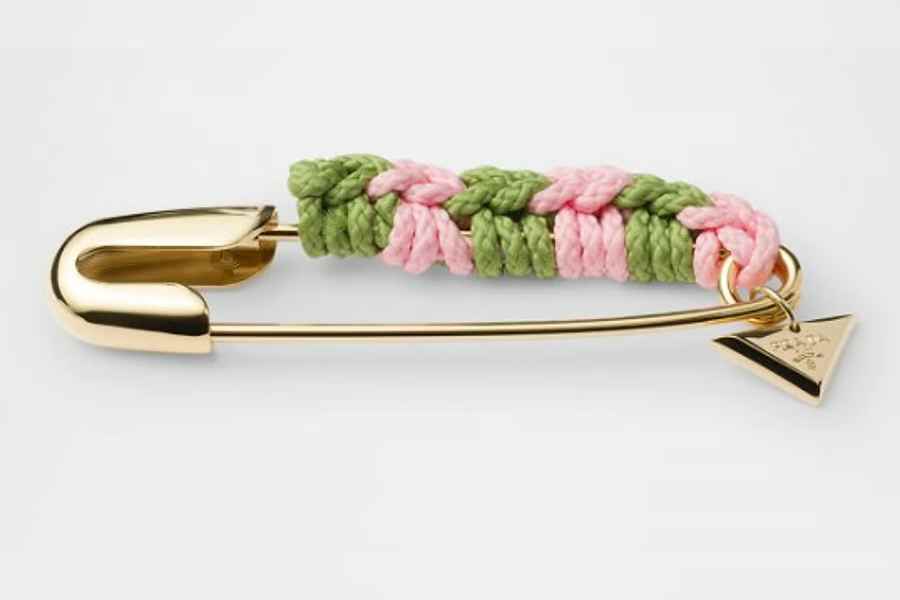Prada’s latest accessory—a simple metal safety pin priced at ₹69,000—has sparked global laughter and outrage. Social media users mocked the “luxury” item by recreating it cheaply, questioning modern branding and value. While critics call it absurd, others see it as performance art, proving Prada still knows how to provoke conversation.

When Italian luxury house Prada released its latest accessory—a simple metal safety pin brooch priced at an astonishing ₹69,000 (US $775)—the fashion world didn’t gasp in awe. It laughed. And then it got angry.
In a matter of hours, the minimalist “statement pin” had gone viral, not because of its design, but because of its price tag. What was once a humble sewing essential, sold in bulk for a few rupees at your neighborhood store, was suddenly rebranded as a symbol of high fashion.
The Prada safety pin is, at first glance, almost aggressively ordinary. A gleaming metal pin, sleek and functional, with a small pastel-colored charm bearing the iconic Prada logo. It comes in baby pink, powder blue, and tangerine orange. That’s it. No diamonds. No gold plating. No secret function.
But as the saying goes in luxury fashion—it’s not what it is, it’s who made it.
For Prada, this pin isn’t about fastening fabric. It’s about fastening identity—staking a claim in the space where irony, status, and art collide. But for the rest of the world, especially crafters, crocheters, and small creators, it’s proof that luxury might finally have lost the plot.
The backlash began with disbelief and quickly morphed into a wave of creativity. Across X (formerly Twitter), Instagram, and TikTok, users filmed themselves recreating the “Prada pin” using regular safety pins, bits of yarn, and leftover buttons. Some managed to do it in under 60 seconds.
“Two minutes, one crochet hook, zero regrets,” quipped one Instagram crocheter from Ghaziabad. Another joked, “I’ve got a dozen pins at home—looks like I’m sitting on a goldmine.”
The meme economy pounced. Photos of the safety pin were edited into digital art pieces, captioned with lines like ‘Luxury Gone Wild’ and ‘The Emperor’s New Brooch.’ Within days, the Prada pin had become not just an accessory but a symbol of satire—a glittering reminder of how absurd the price of prestige can be.
To be fair, Prada has always flirted with the avant-garde. From nylon handbags that redefined utility chic to futuristic footwear that blended form and rebellion, the brand thrives on blurring boundaries between everyday and extraordinary.
But this time, the balancing act seems to have slipped from subversive to simply silly. Critics argue that the ₹69,000 pin isn’t so much a fashion statement as it is a marketing stunt—a way to generate virality in a landscape where attention is the new currency.
Yet, others defend it as conceptual art. “Prada isn’t selling a safety pin,” says a Mumbai-based fashion commentator. “It’s selling a story—a statement about irony, industrial design, and exclusivity. The outrage is part of the performance.”
In that sense, the pin works. It has people talking, laughing, debating. It’s not wearable art—it’s conversational art.
But beneath the humor lies a serious question: when does luxury stop being aspirational and start becoming absurd?
In a post-pandemic world where conscious consumption and sustainability dominate the discourse, such ultra-minimalist, ultra-expensive items appear tone-deaf to many. Especially when the same creative energy could have been channeled into supporting artisans or experimenting with sustainable materials.
Luxury’s power, once rooted in craftsmanship and rarity, now increasingly relies on branding and boldness. As one user commented, “It’s not the Prada pin—it’s the Prada audacity.”
And perhaps that’s the real product being sold here: audacity disguised as design.
Ironically, the digital mockery has only amplified the product’s visibility. In a marketing twist that Prada likely anticipated, controversy breeds curiosity. Traffic to the brand’s website spiked, and some reports suggest the pins are already selling out in select markets.
What began as a punchline has become an experiment in modern luxury economics. In the meme era, attention equals value—and in that sense, Prada’s ₹69,000 safety pin may just be the smartest (or most cynical) piece of marketing this year.
Whether you see it as art, arrogance, or accidental genius, Prada’s safety pin has done something few luxury items manage—it’s become part of culture. It’s inspired parody, debate, and perhaps even introspection about what luxury really means in 2025.
Because if a safety pin can cost ₹69,000 and still make people laugh, cry, and create, maybe it’s worth something after all—just not in the way Prada intended.
Discover more from Creative Brands
Subscribe to get the latest posts sent to your email.





